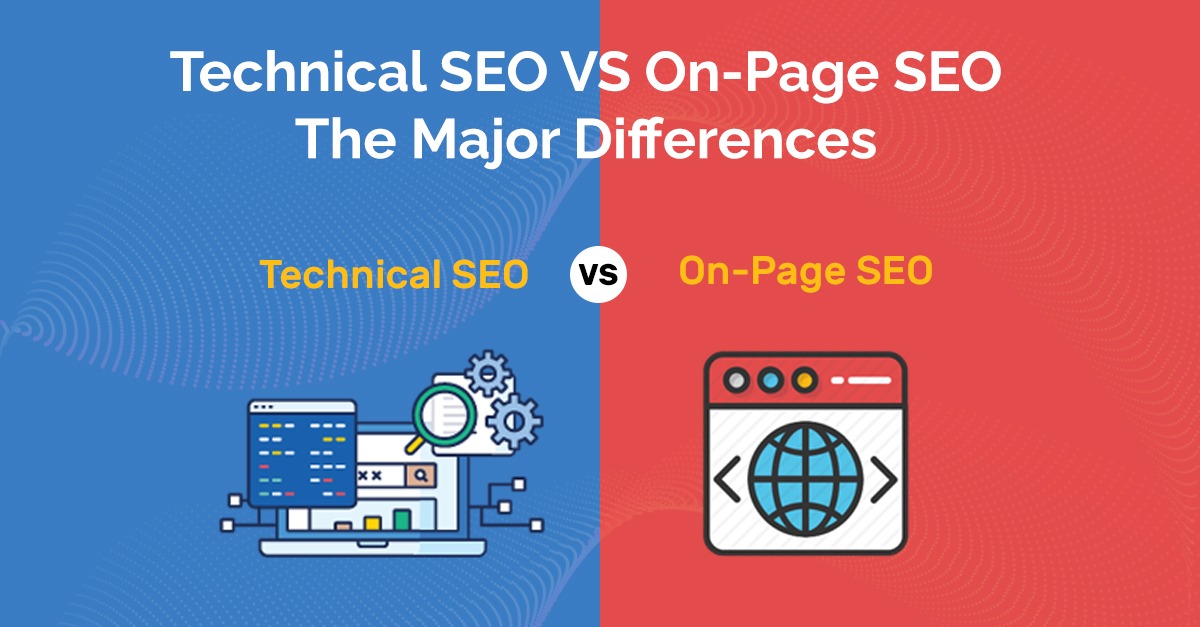
Table of Contents
Introduction
Help different sides of the same website…
You want visitors searching for your firm or hobbies to find out about your website. SEO can help! Search engine optimization (SEO) enhances a website’s readability for crawlers such as Google. On the other hand, technical SEO makes sure search engines crawl and index your website. Technical SEO and on-page SEO are likely to be the emphasis of this particular essay.
Technical SEO includes your website’s “backend” that search engines notice. While on-page SEO involves your website’s content and structure. Now if you desire to function your website, you need to discover the major differences between them and the interplay. Without wasting much time, let’s get acquainted with the basic principles of technical SEO and on-page SEO so that it can help you notice the difference between the two.
What is Technical SEO?
Technical SEO is all about optimising the technical components of your website to make it easy for search engine crawlers or spiders to crawl, index, and render your web pages. In short, it emphasizes making sure that a website caters to the technical needs of modern search engines intending to enhance organic rankings and user experiences.
Vital Components & Practices Implicated in Technical SEO
Website Architecture Optimization
Technical SEO assists in optimising the architecture and structure of websites. This implies arranging the website’s pages and information in a hierarchy to enable easy navigation and improved understanding for visitors and search engine crawlers.
Enhancing Crawling and Indexing
Technical SEO encompasses optimization of crawling and indexing to make sure search engine crawlers can effectively access and crawl the website’s content. This further includes creating and submitting XML sitemaps, optimising robots.txt files as well as using meta tags to direct search engines on what to crawl and index.
Enhancing URL Structure and Keyword Cannibalization
URL structure and canonicalization are crucial in technical SEO. precise and descriptive URLs following relevant keywords enhance user experience as well as search engineer visibility. Canonicalization solves duplicate content issues by spotting the preferred webpage version and overlooking search engine penalties.
Website Performance & Speed Optimization
Technical SEO focuses on website performance and speed. This includes multiple techniques such as image optimization, decreasing CSS and JvaScript files, using browser caching, and embracing content delivery networks (CDNs) to enhance the efficacy and loading speed of the website.
Mobile Responsiveness
Responsive design and mobile optimization are vital facets of technical SEO. To offer the best user experience and attain greater rankings on search engine results, a website is required to be mobile-friendly, responsive, and adaptable to multiple devices
Note: Different activities involved in enhancing a website’s Core Web Vitals are a crucial part of Techni SEO.
What is On-Page SEO?
On-page SEO is all about strategically optimizing your website’s elements. Doing so helps enhance your web page’s visibility and pertinence in search engine results, thereby alluring more organic traffic.
Vital Components and Practices Implicated in On-Page SEO
Keyword Research & Optimization
Finding relevant keywords that sync with the content and user intent and also strategically integrating them across the webpage to improve visibility and rankings.
Meta Tags Optimization
Curating compelling and descriptive meta tags, encompassing title tags and meta descriptions, to assist search engines in understanding webpage content and excite users to click through the search results.
Content Optimization
Laying out webpage content efficiently by streamlining headings, making sure appropriate keyword density, and executing internal linking strategies to enhance user experience and drive easily understandable content indexable by search engines.
URL Optimization
Developing precise, descriptive, and SEO-friendly URLs encompassing targeted keywords, assisting search engines and users in swiftly understanding the content and enhancing webpage visibility and click-through rates in search engines.
Image Optimization
Compacting image files to minimize the page load time, enhancing website speed, and utilizing lt tags to offer descriptive text for images. This enables search engines to understand image content and improves accessibility for visually impaired users.
The Reciprocity Between Technical SEO & On-Page SEO
Here is the table that delivers a glimpse at the reciprocity between technical and on-page SEO.
Website Structure
Technical SEO: Optimization of the website architecture hierarchy, and navigation to ensure a cerebral and user-friendly structure.
On-Page SEO: Optimization of the website, navigation, executing breadcrumbs, enhancing internal linking structure, and improving user experience with concise and intuitive website structure.
Indexing and Crawling
Technical SEO: Contextual interlinking
On-Page SEO: Ensures appropriate URL structure, using canonical tags, and executing schema markup, thereby optimizing XML sitemaps for improved indexing and crawling.
Website Speed
Technical SEO: Optimization of website performance, minifying CSS and JavaScript files and html code. Optimizing images, embracing browser caching, and using content delivery networks (CDNs) to enhance website loading speed.
On-Page SEO: Optimization of file sizes, embracing browser caching, minimizing caching, minimizing server response time, and executing effective coding practices to improve webpage loading speed.
Mobile-Friendliness
Technical SEO: Making sure responsive web design, optimization for mobile devices, executing mobile-friendly layouts, and enhancing the user experience on different screen sizes.
On-Page SEO: Developing mobile-friendly webpages, optimization of viewpoint settings, using responsive images, and improving mobile navigation and user interface to offer an easy experience on mobile devices.
URL Structure
Technical SEO: Optimization of URL structure to be precise, descriptive, and keyword-rich as well as overlook duplicate content issues.
On-Page SEO: Eliminating unwanted parameters and making sure appropriate use of redirects (301/302) to improve search engine visibility.
Conclusion
To augment the influence of SEO, it’s vital to hit a balance and merge the approaches of Technical SEO and On-Page SEO. SEO is a collective input, hence, you need to optimize all the pertinent components- that further encompass Local, Offpage SEO, etc.
Technical SEO and On-page SEO can help your website rank better in search results. Hence, it’s crucial to know the interplay. Emphasising both types of SEO can also help prospective visitors, and consumers discover you.
No matter whether you’re a company owner or just want to boost your website’s visibility’ remember we at Smartinfologiks are by your side and keep in mind to emphasize both technical SEO and on-page SEO.


